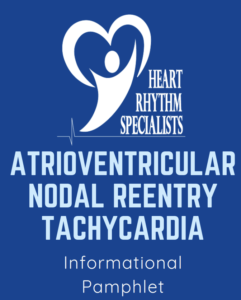What is AVNRT?
Atrioventricular nodal reentry tachycardia (AVNRT) is the most common type of supraventricular tachycardia (SVT), which is an abnormally fast heartbeat. It is caused by a reentrant circuit (an accessory pathway) located in or near the atrioventricular (AV) node. This reentrant circuit can cause the heart to beat prematurely, leading to fast heart rates (tachycardia).
How is AVNRT Diagnosed?
Dr. Yoo will use a combination of
a physical exam, medical history,
and testing, which may include:
- electrocardiogram (ECG/EKG)
- Holter monitor
- echocardiogram
- stress test
- electrophysiological (EP) test
Risk Factors include:
- middle to older age
- history of heart attack, heart
failure, or heart disorders - history of heart surgery
- thyroid problems
- certain drugs and supplements
- anxiety or emotional stress
- physical fatigue
- diabetes
- obstructive sleep apnea
- pregnancy
- chronic lung disease
Causes of AVNRT include:
- certain medications, like those for asthma, colds, and allergies
- smoking, drinking
- caffeine
- drugs and stimulants
- prior cardiac surgery
Symptoms of AVNRT
Episodes of AVNRT often start and end suddenly. Symptoms
include:
- fluttering in the chest
- rapid heartbeat (palpitations)
- shortness of breath
- lightheadedness or dizziness
- sweating
- pounding
- sensation in the neck
- fainting (syncope) or nearfainting
Treatments for AVNRT
Dr. Yoo will determine the type of treatment necessary based on the frequency of your episodes and the symptoms they cause. Treatments may include: cardioversion, antiarrhythmic medication(s), a catheter ablation procedure, a pacemaker implant, or Vagal maneuvers.
It is a good idea to keep a log of your heart rate, symptoms, and
activity at the time of an episode in order to know what triggers to avoid.
Additional Resources
